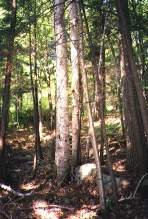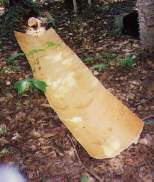
 |
Birchbark forms the outside of a birchbark canoe. Contrary to popular opinion (and the folks who make Sportspal canoes) the bark is used inside out. The white side is on the inside and the pinkish inner side is on the outside of the canoe.
 The
bark comes from a White Birch tree, Betula papyrifera Marsh. This tree
is common throughout Canada and the northern United States. White birch trees
need light to grow so they are found on burnt over land or where trees have
been cut, or along the sides of roads. They grow up to 80 ft high with a 2 ft
diameter. Birchbark is a wonderful material that can be cut, bent and sewn.
It is waterproof and resists decay.
The
bark comes from a White Birch tree, Betula papyrifera Marsh. This tree
is common throughout Canada and the northern United States. White birch trees
need light to grow so they are found on burnt over land or where trees have
been cut, or along the sides of roads. They grow up to 80 ft high with a 2 ft
diameter. Birchbark is a wonderful material that can be cut, bent and sewn.
It is waterproof and resists decay.
Finding a suitable birch tree for making a canoe is not easy. To start with, the tree has to be very straight and without branches or large knots for the length of your proposed canoe. Then the bark has to be thick enough and flexible. It should be at least 1/8" thick and 1/4" is better. To test the bark, canoe builders remove a sample piece before cutting a tree down. The bark must not split apart into layers and it must not split along the eyes when it is bent either way. The eyes should be short and widely spaced. The circumference of the tree is important since this will dictate whether extra side panels will be needed but the quality of the bark is more important than the size of the tree.
To use birchbark it has to be removed carefully from the tree. You can either cut the tree down or remove the bark while the tree is standing. I am told that removing the bark does not harm a birch tree but it never grows back so I would think it would leave the tree vulnerable to disease.
 The
photo shows peeling the bark from a small tree. I have made a cut through the
bark down the tree and I am prying the bark off gently with a plastic spatula.
It took about an hour to remove a piece about 7 feet long. I made two very nice
model canoes from it and used some of it in my full-size canoe. (click on the
image to see it bigger). I used the bark off the lower part of this tree one
year and went back later and cut the tree down to use the rest of the bark.
I will use the wood for making thwarts or other things. It's good not to waste
a tree.
The
photo shows peeling the bark from a small tree. I have made a cut through the
bark down the tree and I am prying the bark off gently with a plastic spatula.
It took about an hour to remove a piece about 7 feet long. I made two very nice
model canoes from it and used some of it in my full-size canoe. (click on the
image to see it bigger). I used the bark off the lower part of this tree one
year and went back later and cut the tree down to use the rest of the bark.
I will use the wood for making thwarts or other things. It's good not to waste
a tree.
After it has been removed from the tree it can be rolled up for transportation and storage.
If the bark is removed from the tree in winter or early spring, it retains the dark inner layer that can be scraped off to make a design.. Bark like this is called "winter bark" but I have found it on trees in early September.
 It's
important to get permission to use a birch tree from whoever own the land it
is growing on. Birchbark theft is a growing problem in some areas, especially
in the United States and canoe builders may be blamed for this.
It's
important to get permission to use a birch tree from whoever own the land it
is growing on. Birchbark theft is a growing problem in some areas, especially
in the United States and canoe builders may be blamed for this.
I was lucky enough to trade some of my computer skills with Jack Lapointe of Westport Canoes for a roll of bark he had gathered several years before. This piece was 15 feet long, 37 inches wide at one end and 43 inches wide at the other. This and some smaller pieces I gathered formed my canoe.
Back to the Materials page
© Judy Kavanagh 2001